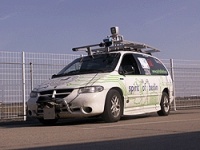Researchers working on the AutoNOMOS Project at Freie Universität Berlin believe this level of autonomy could lead to safer motoring.
The AutoNOMOS so-called Brain Driver converts bioelectric brainwaves called electroencephalograms (EEG) into commands read by a computer-controlled vehicle.

Tests proved wave patterns read by head-mounted sensors could be interpreted as commands for direction, acceleration and braking.
For thoughts to produce a vehicle response the test subject must first train the computer to respond correctly.
He or she thinks of a individual situation for one of four commands — stop, start, left and right. The associated brain waves are then read by Brain Driver sensors and recorded by the car’s computer.
AutoNOMOS has proved when these thoughts are repeated the computer is able to prompt the correct response form the vehicle.
Brain commands are combined with a navigation map that recognises the road, other vehicles and pedestrians.
In practice, the computer can adhere to prescribed rules well, but situations requiring intuitive assessment are more difficult.
‘Getting a car to stay on the road and interpret what other cars are doing is possible. But detecting pedestrians, knowing how they move and then knowing what they are thinking, is a problem,’ Prof Raúl Rojas, who heads the AutoNOMOS project, told The Engineer.
The project’s impetus remains a ‘technological push’ rather than working towards commercial application. ‘While there is already a demand pool, for example with disabled drivers, we are still just seeing what we can do,’ said Rojas.
EEG sensor reading also has potential to improve car safety. It is claimed Brain Driver will be able to recognise if a person falls asleep at the wheel. In this situation, the driver would be woken with a noise or vibration.
AutoNOMOS is part of research into fully autonomous vehicles and Rojas and his team have a vision for the future. ‘Eventually, we see cars being taxis without drivers. No one will own a car; you will own mobility.’
Author: Damien Gabet





Swiss geoengineering start-up targets methane removal
No mention whatsoever about the effect of increased methane levels/iron chloride in the ocean on the pH and chemical properties of the ocean - are we...